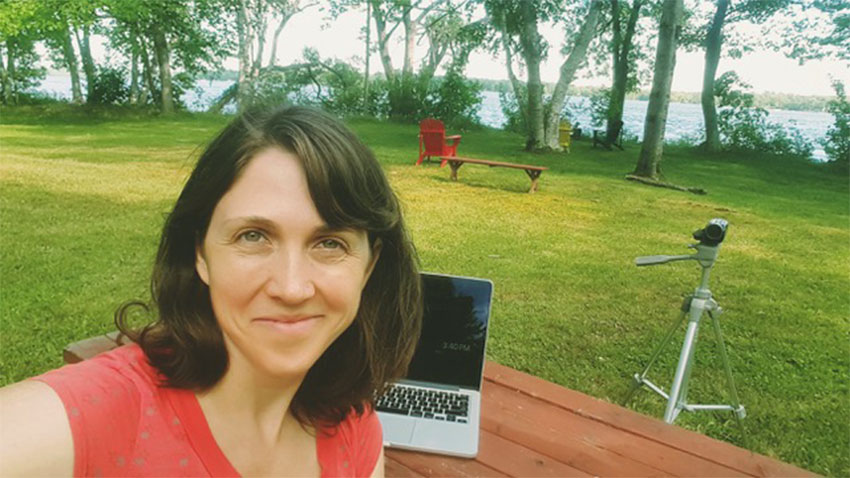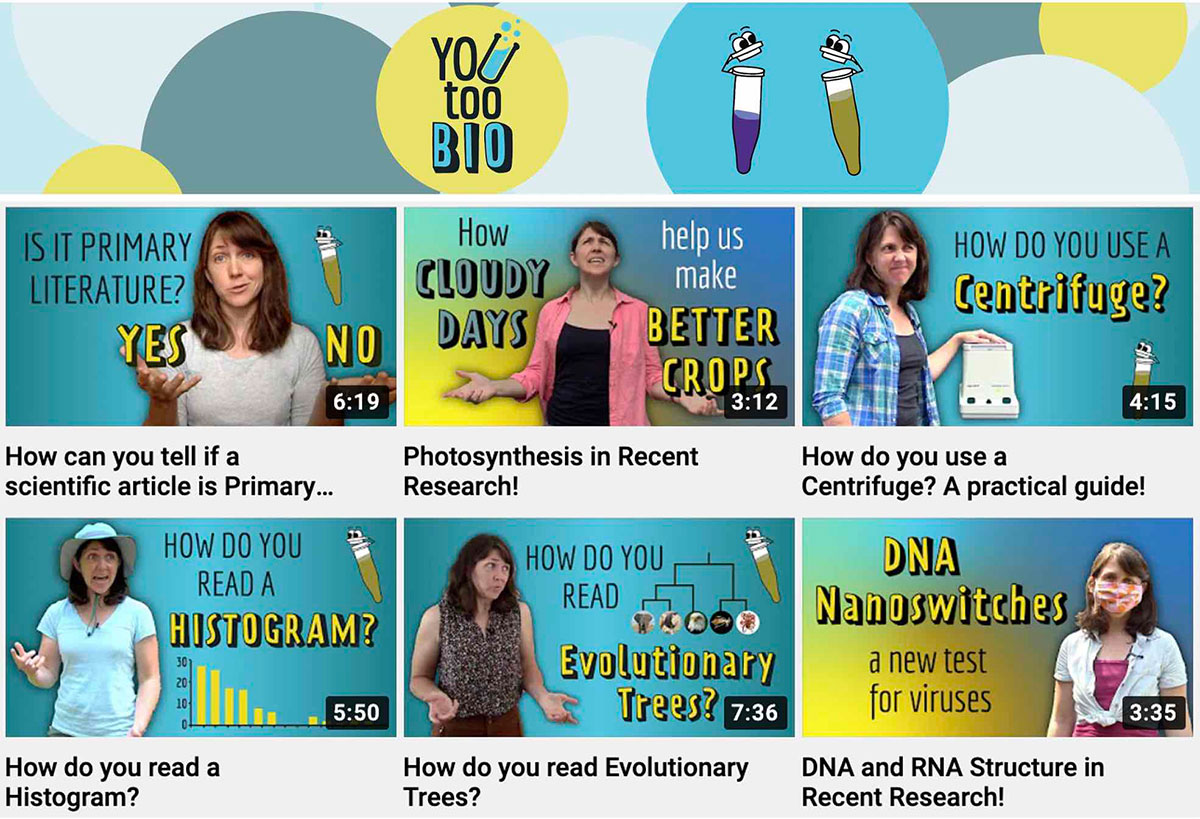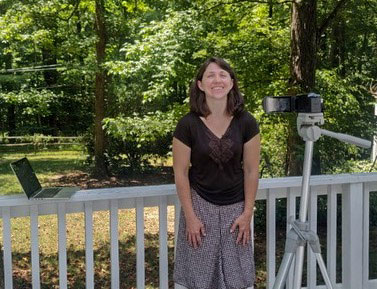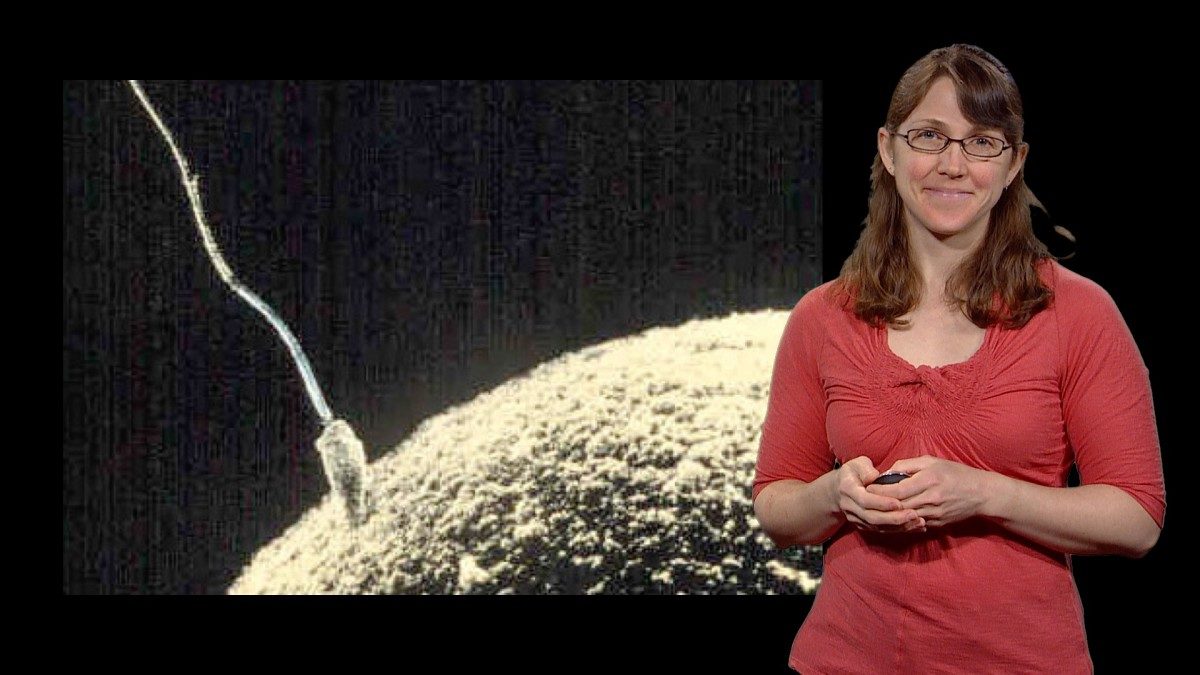Dr. Jayme Dyer has been impressing us at iBiology since 2015. Her iBiology talk, Gradient Tracking: How Cells Drive Without Eyes, is one of our most popular YSS videos. As a biology educator, she often found times where she wished she had a video to demonstrate an idea or concept, but couldn’t quite find what she needed. So, she started making them herself on her YouTube channel, YouTooBio. We caught up with Jayme to find out more about what she’s been up to since her time in the iBiology studio.

You were part of our first cohort of Young Scientist Seminars winners (now called the Share Your Research Competition). What have you been up to since then?
When I filmed my YSS talk, I was doing a postdoc at MIT (and I was 4 months pregnant!). Since then, I’ve had 2 kids and 1 major life-priorities re-assessment. After I had my first baby during my postdoc, I had to reckon with a work-life balance that no longer felt sustainable. My long-term goal had always been to teach – and that didn’t change – but the type of teaching position I sought did. I left my postdoc in 2016 and I’ve been working part-time as an adjunct instructor ever since. I’m so much happier and well-balanced now! In addition to having time to teach and time with my kids, I also have time to engage in scicomm and science outreach – I’ve been a judge for local science fairs, I’ve volunteered for “Meet a Scientist” events at local museums, I’ve tutored high school and college students, I led a summer mini-science camp for elementary students, and I started YouTube channel for science educators, called YouTooBio.
What inspired you to start creating your own videos and launch your channel?
As an educator, I have always assigned videos as homework for my students, and there have always been videos that I wanted to assign but didn’t exist. I remember the first time I taught a lab course in 2013 when I was teaching as a Visiting Assistant Professor at Earlham College. I wanted to assign a video that introduced the micropipette and how to use it. At first glance there are a lot of videos on YouTube that do that, but – wow! – they are soooo boring. I wanted something short, engaging and funny – while also hitting all the key points. Like, when they talk about needing to put a tip on the micropipette, show someone putting a micropipette without a tip into liquid with dramatic music and lights flashing with NEVER DO THIS – or something like that. This type of video just didn’t exist.

Later, I was tutoring a college student who was taking a senior seminar. She was reading papers left and right and trying to interpret figures, but she didn’t understand what half of the techniques were. I remember teaching her what a Western Blot is and just wishing I could send her a 7-minute video that introduced the Western Blot while also showing the physical aspects of the technique – because I think students understand the concept so much better when they can see that the proteins run in a gel (like, literally a floppy piece of goo) that are then transferred to a sticky surface for antibody detection. While videos exist for some techniques, they are either all cartoons, or they focus too much on the protocol and are not appropriate for Introductory-level students. The video I wanted to assign to her just didn’t exist.
Finally, I’m a huge proponent of teaching with data from the very beginning of the curriculum, but there is a dearth of introductory-level videos on YouTube that discuss real scientific data. Many students take an introductory science course and it is their only science class for the rest of their lives. If these introductory courses teach science as just facts to memorize, then we miss the opportunity for them to learn that science is a method, not just a collection of facts. In an age with widespread scientific mistrust, I think it is critical to integrate scientific “facts” with the data that support them to really help students understand that science is about making conclusions based on data. There are many great videos introducing basic biological concepts – I assign them to my students all the time – but they rarely ever discuss data. I wanted to assign videos that integrate Introductory-level concepts with real data from real research – but those videos just didn’t exist.
Since no one else was making the videos I wanted to assign to my students – I started making them!
What has been the most challenging part of starting your channel?
Wow, video production takes a lot of time! I finally made that How Do You Use a Micropipette? video I envisioned so long ago, and it took about 40 hours to produce a 6-minute video. So it’s definitely a big time commitment. Luckily, I have a life partner who can support our family financially, so I was able to take off the entire summer last year to produce videos. Balancing video production while also creating my first online-only Introductory Biology course last fall was a challenge. When we had a gap in childcare from mid-November until January, I was the primary caregiver while my partner worked a full-time job, so I didn’t produce any videos during that time (but I did get lots of quality time with my kids!).

Producing my own videos has been a huge time commitment, but starting my channel has helped me learn so many cool things! It’s neat to see how I’m getting better (far from perfect!) at all the aspects of video production – filming, following a script, video editing, making illustrations, promoting myself on social media (I just joined Twitter last summer and I’m still getting a handle on it…haha). When I watch videos on other channels, I’m now much more aware of the tricks they employ in their videos, like little background whooshes and dings, scene transitions, that sort of thing. It’s like peeking behind the curtain a little bit – it’s fun! – and it helps me make my videos better.
The other surprising consequence of starting YouTooBio is that because I discuss real scientific data in every video, I’m reading scientific articles more than I ever did, even as a PhD student or postdoc! There is so much cool science happening all the time and ironically, when I was in the lab, I was too busy to read it! I’ve really enjoyed learning about research on lots of different topics.
As an educator, how do you like to use videos in your classroom?
Mostly, I assign videos as homework. My students watch one or two videos, then they complete a related activity. I find it’s helpful to have students exposed to the material more than once, and also for them to encounter the content from multiple sources, since hearing something explained multiple ways helps reinforce the core concepts.

You’ve been active in science communication in so many different ways. Do you have any advice for students or researchers interested in expanding their scicomm skills?
Practice communicating science to a variety of audiences – and, importantly, pay attention to what works and what doesn’t and adjust accordingly.
The advice about having an elevator speech is really important. Make it a really good hook. For my PhD, I studied cell polarity and gradient tracking during mating in yeast, which is a pretty dry topic until you turn it into I STUDY HOW YEAST HAVE SEX. That turns heads at parties and gets people engaged.
But it’s not enough to have an elevator speech, you have to use it! Talk to non-scientists about your research or the cool paper you read last week. And this is important: pay attention to what works and what doesn’t. I remember being on the train on my way to the YSS training workshop, and I was sitting next to this young guy and we were chatting about science and we’d gotten on the topic of the microbiome. And I nonchalantly said, “I mean, you know that 50% of the cells in your body are bacteria cells, right?” And he literally said to me, “No, how would I know that?” I appreciated his candor because it helped me realize where he was – and how I needed to adjust my expectations to have a real two-way conversation with him.
You get better at scicomm by practicing – and practicing means making mistakes. Yes, you’ll make mistakes. Great! They’re opportunities to learn and get better.
Oh yeah – and when you have the crazy lark of an idea to do or try something new – do it! Figure out how to fit it into your life, and just do it. Make mistakes! Learn from them. Repeat.
You can check out Jayme Dyer’s videos on her YouTooBio channel on YouTube, and if you want to keep up with all of her latest content, you can subscribe to her newsletter.





Leave a Reply